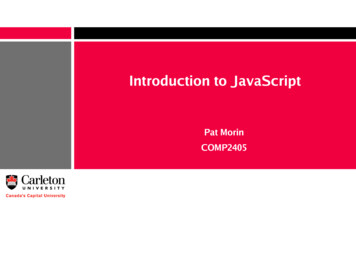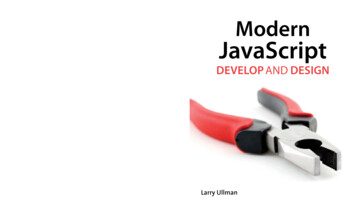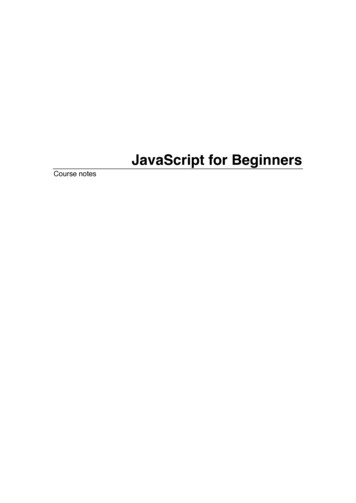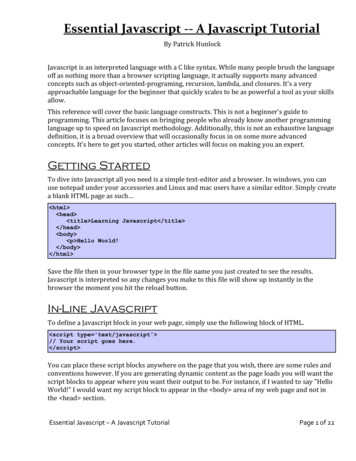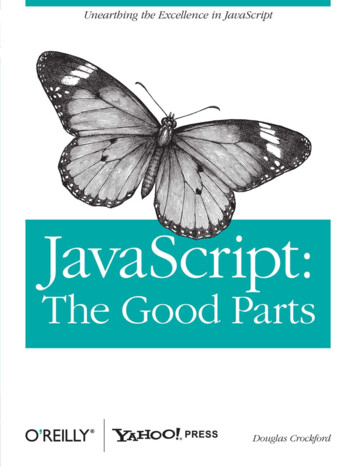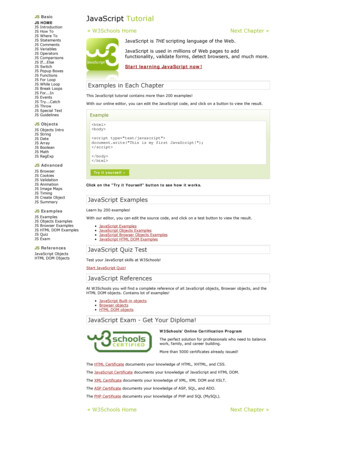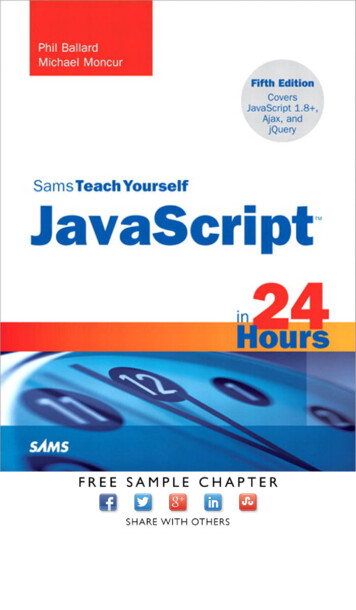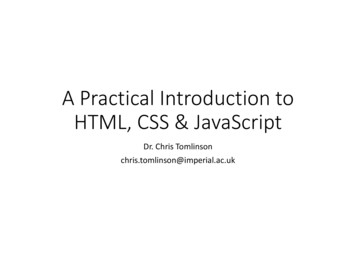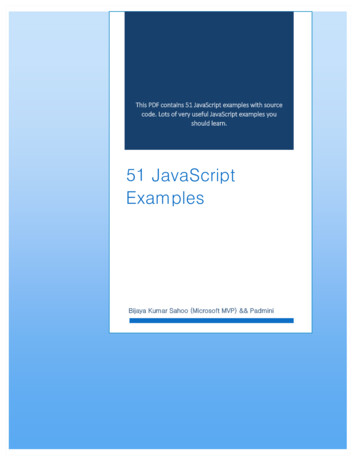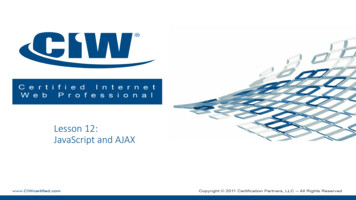
Transcription
Lesson 12:JavaScript and AJAX
Objectives Define fundamental AJAX elements and procedures Diagram common interactions among JavaScript, XML and XHTML Identify key XML structures and restrictions in relation toJavaScript Explain how the XMLHttpRequest object interacts with XML Use the XMLHttpRequest object to retrieve data Describe typical AJAX-based requests Identify key server response issues related to AJAX-based requests Use JavaScript to communicate with databases Identify alternatives to XML-based AJAX
Introduction to AJAX AJAX (Asynchronous JavaScript and XML) A technology that combines functionality from JavaScriptand XML to allow a Web page to reload only a specifiedportion, rather than the entire page, in response to arequest The XMLHttpRequest object A JavaScript object that is used to request either XMLdata or plaintext data from a Web server
Introduction to XML XML (Extensible Markup Language) A meta-language that enables the developer to createunique tags for structuring Web documents based oncontext rather than appearance Valid XML Is well-formed and references a DTD Well-formed XML Conforms to strict, specific syntax rules
Interactions AmongJavaScript, XML and XHTML Common interactions in AJAX Relating XML structures and restrictions toJavaScript Key structures Restrictions How XMLHttpRequest interacts with XML
Using AJAX Scripts There are three basic JavaScript functions in atypical AJAX request: A function that creates an HTTP request A function that calls and submits the HTTP request A function that handles the data returned to the page
AJAX and Servers Typical AJAX-based requests Returning server variables from the server to the client Parsing XML and data Sending entire pages of information in a native language to the server forinterpretation and retrieval Server response issues with AJAX Partial responses Unfinished responses
AJAX and Databases Relational databases Relationships in databases Using AJAX with a database Security issues with AJAX and databases
Usability Issues with AJAX Bookmarking Search engines Back button Script blocking ActiveX blocking
Combining AJAX with Libraries AJAX Works well with data and server-side applications Works well with JavaScript libraries
Alternatives to XML-based AJAX Java applets Adobe Flash Microsoft Silverlight
Summary Define fundamental AJAX elements and procedures Diagram common interactions among JavaScript, XML and XHTML Identify key XML structures and restrictions in relation to JavaScript Explain how the XMLHttpRequest object interacts with XML Use the XMLHttpRequest object to retrieve data Describe typical AJAX-based requests Identify key server response issues related to AJAX-based requests Use JavaScript to communicate with databases Identify alternatives to XML-based AJAX
Lesson 12 Quiz1. AJAX refreshes the Web page by:a. using Microsoft APIs and function calls from the DOM.b. re-requesting the page from the database using SQL commands.c. making server requests via XMLHttpRequest to refresh the entire page.d. making server requests via XMLHttpRequest to refresh the requestedportion of the page.
Lesson 12 Quiz1. AJAX refreshes the Web page by:a. using Microsoft APIs and function calls from the DOM.b. re-requesting the page from the database using SQL commands.c. making server requests via XMLHttpRequest to refresh the entire page.d. making server requests via XMLHttpRequest to refresh the requestedportion of the page.
Lesson 12 Quiz2. To be considered well-formed, XML code must conform to strict syntaxrules. In order to be considered valid, an XML document must:a. reference the DOM.b. be well-formed and reference a DTD.c. be used in an AJAX implementation.d. use tags specified by XHTML Transitional.
Lesson 12 Quiz2. To be considered well-formed, XML code must conform to strict syntaxrules. In order to be considered valid, an XML document must:a. reference the DOM.b. be well-formed and reference a DTD.c. be used in an AJAX implementation.d. use tags specified by XHTML Transitional.
Lesson 12 Quiz3. Consider the following script:if(navigator.appName "Microsoft Internet Explorer") {http new ActiveXObject("Microsoft.XMLHTTP");} else {http new XMLHttpRequest();}This code will:a. check to see if the script uses AJAX.b. ensure the script exits gracefully if XMLHttpRequest is invalid.c. check for browser compatibility.d. check for ActiveX objects running.
Lesson 12 Quiz3. Consider the following script:if(navigator.appName "Microsoft Internet Explorer") {http new ActiveXObject("Microsoft.XMLHTTP");} else {http new XMLHttpRequest();}This code will:a. check to see if the script uses AJAX.b. ensure the script exits gracefully if XMLHttpRequest is invalid.c. check for browser compatibility.d. check for ActiveX objects running.
Lesson 12 Quiz4. Which choice demonstrates the proper syntax for linking an externalAJAX/JavaScript file?a. script href "jquery-1.4.4.min.js" / b. script href "jquery-1.4.4.min.js" /script c. script src "jquery-1.4.4.min.js" / d. script src "jquery-1.4.4.min.js" /script
Lesson 12 Quiz4. Which choice demonstrates the proper syntax for linking an externalAJAX/JavaScript file?a. script href "jquery-1.4.4.min.js" / b. script href "jquery-1.4.4.min.js" /script c. script src "jquery-1.4.4.min.js" / d. script src "jquery-1.4.4.min.js" /script
Lesson 12 Quiz5. Which of the following is an alternative to XML-based AJAX?a. Flashb. Structured Query Language (SQL)c. The HTMLHttpRequest objectd. JavaScript
Lesson 12 Quiz5. Which of the following is an alternative to XML-based AJAX?a. Flashb. Structured Query Language (SQL)c. The HTMLHttpRequest objectd. JavaScript
AJAX (Asynchronous JavaScript and XML) A technology that combines functionality from JavaScript and XML to allow a Web page to reload only a specified portion, rather than the entire page, in response to a request The XMLHttpRequest object A JavaScript object that is used to re


